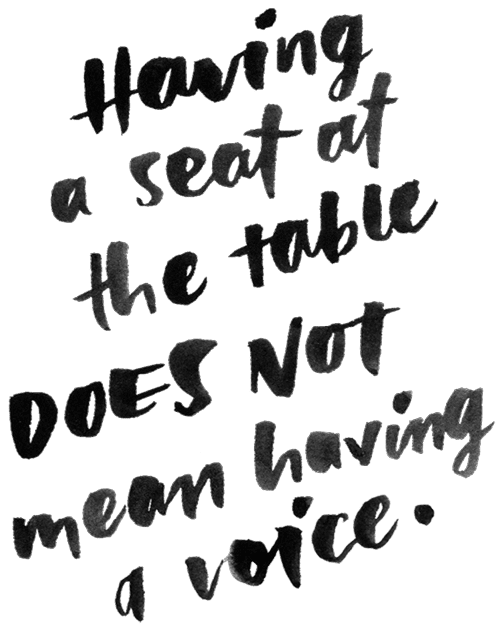Groundbreaking BYU research shows what it takes for a woman to truly be heard.
Illustration by Olivia Juárez Knudsen (BFA ’10)
If anything, the women were more qualified than the men.
“I mean, these are extraordinarily bright women,” BYU political-science professor Jessica R. Preece (BA ’03) says of the women in their latest study. “And yet, we see these patterns . . . ,” she says, trailing off.
She and her BYU colleagues set out to examine the female experience in a top-10, predominately male collegiate accounting program—a program where the women, overall, matriculated with higher GPAs and more leadership experience than their male peers. The students move through the program on teams, and administrators wanted to know how best to build them. Traditionally, they spread the women out—for diversity, right?
The researchers were well suited: political-science professor Christopher F. Karpowitz (BA ’94, MA ’96) is a nationally recognized expert on group gender dynamics, and Preece and economics professor Olga Stoddard basically run a gender think tank at BYU, the Gender and Civic Engagement Lab.
Here’s the short of it: even though both men and women reported loving their groups, because of the study’s findings, the program will not put a woman alone on a team of men again.

What happens when women are outnumbered? After years spent analyzing lab and real-life settings to determine what it takes for a woman to really be heard—to truly be perceived as competent and influential—these professors have found the same truth: for women, having a seat at the table does not mean having a voice.
“Women are systematically seen as less authoritative,” says Preece. “And their influence is systematically lower. And they’re speaking less. And when they’re speaking up, they’re not being listened to as much, and they are being interrupted more.”
This applies well beyond study groups.
“Group-level decision making is ubiquitous,” says Karpowitz. It ranges from the highest level, where men and women work together in Congress and the U.S. Supreme Court, on down to juries, town halls, PTAs, and work teams. It applies even on Church ward councils and in families, he stresses. In one realm or another, no one falls outside the scope of this research.
However inadvertent, the gender dynamics shutting women down are real, says Preece. The environment, she emphasizes, doesn’t have to be hostile. “Multiple things can be true at once. You can simultaneously like the people you’re working with and still let biases creep in.”
Rather than outright misogyny, she says it’s usually cultural norms and gendered messages that subtly—and profoundly—shape the rules of engagement. Individuals who suppress female speech may do so unwittingly. “They may love women,” says Preece. “They may even be a woman!” But as a society we have been “slowly socialized over years to discount” female expertise and perspectives.
The problem, in part, could be you. Says Preece: “We have lots of learning and unlearning to do.”

A Crucial Perspective
In some spheres women have the gift of gab—particularly in groups of women. So what if they become demure in other spheres? Why does this matter?
For starters, women are “likely to identify different things as problems in the first place,” says Preece. In politics women often think differently about issues than men do; the literature even shows they can have a cooperative, democratizing impact on deciding bodies. “Women are more likely to think about, What are the needs of families and children and how do we care for those who have the least in our society?” says Karpowitz. “Many men focus on different priorities, such as how to balance the budget or change the tax structure.”

Sidebar: A Political Hole
Women now outpace men in education and voter turnout but are politically “opting out,” say Preece and Stoddard, in every other metric, from casual political dialogue to representation on the ballot.
He sees threads of this at BYU.
“Some of my most impressive students have been women here at BYU whose core interest is, How do I simultaneously prioritize my family and my scholarly work? I never hear male students talk like that. Ever. And yet that balance . . . ought to be just as important for men.”
The researchers cite Church leaders like Sister Reyna Aburto in her April 2018 general conference talk, “With One Accord,” in which she spoke of counseling together: “Revelation is scattered among us, and when we put that revelation together, we can see more.” Or President M. Russell Ballard’s 1994 “Counseling with Our Councils,” in which he called for “sisters to have full opportunity to contribute” and compared the effect of asking the sisters for their ideas to “opening the floodgates of heaven.”
What’s more: women’s involvement changes group behavior—and outcomes.
Karpowitz never set out to study gender. His PhD work at Princeton was trained on group decisions—how ordinary people reach consensus, how individuals establish influence and authority, or “the idea that other people will listen, believe there is value in what is being said, and might even change their opinions in response to that.” But as he and Princeton colleague Tali Mendelberg examined another scholar’s dataset, the gender differences were nothing short of “dramatic.”
In the study, groups chose how to divvy up money. Women could not influence a group’s outcome unless there were a lot of them—and those groups reached very different conclusions. Groups with more women gave more generously to the people with the least. And the people in these groups reported feeling happier with their decisions. “That struck us as really important to understand,” says Karpowitz.

Upon his arrival at BYU in 2006, he and Mendelberg set out to unpack it. In a series of studies, they’ve shown that women can bring new perspectives and solutions—but only when they are able to participate.
That’s the hang-up.
“In real time,” he says, “we were able to get this view of how it is that women can be disempowered.”
The evidence is amassed in their award-winning book, The Silent Sex, which the International Society of Political Psychology as well as the American Political Science Association’s political psychology and experimental research sections each named the best book of the year. And their findings are instructive for us all.
How Women Are Disempowered
The Karpowitz and Mendelberg studies began with a large controlled experiment in which groups of five, with varying gender compositions, were asked how to split their collective earnings—and how economic redistribution should work in society at large.
Half of the groups were assigned to decide by majority rule—the most common protocol decision-making bodies use. Here’s what happened in those groups:
Unequal Talking Time: Equality would suggest that each person in a group of five has the floor 20 percent of the time, but it took not just a female majority but a supermajority (meaning four out of five) for women to finally speak their proportionate talking time. At best, outnumbered women in the study spoke three-quarters of the time a man spoke; on average, women spoke just two-thirds as much as a man. And missing voices means missing perspectives: they weren’t bringing up things they had said, in surveys beforehand, that they cared about.
A lone female spoke the least. A lone male? Nothing will hold him back, Karpowitz and Mendelberg found. “Men are willing and eager to jump into conversations, and they come with a level of confidence where they just expect themselves to be influential,” says Karpowitz. “They go for it no matter what.”
Routinely Interrupted: Ever had someone cut you off? Maybe it was argumentative—an “I don’t think so” or “That’s not right”—or maybe the person just talked over you, stole the floor. Such negative interruptions, says Karpowitz, “sap the authority of the speaker,” and men commit them most. Interestingly, the patterns of negative interruptions are also tied to gender composition. Put a woman alone with four men, and 70 percent of the interruptions she receives from men are negative. Compare that with having four women in the room: here, just 20 percent of the interruptions women receive from men are negative. To quote the study, when women have the numbers, “men undergo a drastic change. They become far less aggressive.”
Limited Influence: The researchers asked group members individually who in their group was most influential. Talking time predicted everything: those who held the floor most won. Ergo, “the same conditions that create disproportionate silence by women also create disproportionate authority by men,” Karpowitz and Mendelberg write.

A Possible Solution
Karpowitz and Mendelberg’s work sent such huge ripples through the field because of what they did with the other half of the groups. These were assigned to make their decisions via unanimous rule. It was the first-ever study to look at how gender composition interacts with decision rule.
For outnumbered women, unanimous rule paid dividends:
• Female talking time increased for women in the minority—a lone woman participated nearly as much as a man.
• Unanimous rule significantly increased positive interruptions—interjections that affirm and validate, like “Yeah” and “I agree.” Such positive interruptions tripled for women in the minority. “Women tend to be really sensitive to the signals that other members of the group send,” says Karpowitz. “If the group sends signals that build confidence, women tend to participate more.”
• The influence gap narrowed for a lone woman—she had almost as much of a shot as a man at being voted the most influential member by her group.
“Unanimity rule sends the message that everybody’s voice matters,” says Karpowitz. It’s a huge breakthrough for groups with gaping gender disparities. The bottom line, he says: if you want to empower women, apply majority rule when women have the numbers and unanimous rule—or at the very least, an underlying principle of unanimous rule, hearing from everyone—when they don’t.
Seven Ways to Elevate Women’s Voices

Imagine your next work, ward council, town hall, HOA, or PTA meeting. You can help empower the women in the room.
“We have control over these things,” says Karpowitz. “We can invite more women. If we can’t do that, we can do things to make sure the women who are in the room are able to fully contribute and express views.”
1. Men, Listen Up: “Part of what comes of this research is, for men, the importance of listening,” says Karpowitz. For many men, he says, it’s just a matter of becoming aware of these dynamics. “And again, to do that, men may have to actually be quiet at times,” Karpowitz says with a laugh, “and listen.”
The aim is not some “artificial kind of politeness,” he continues. “We’re trying to think about the conditions under which men and women participate equally and are equally influential, that they see each other as authoritative, without one person or one gender dominating the speaking turns.”
Men enter discussions expecting themselves to be influential. “We’re not trying to denigrate that,” says Karpowitz. “What’s important is for women to feel that way too.”
2. Women, Speak Up: Women especially worry about the reactions of others—they worry that by speaking their minds, they are violating gender roles, says Karpowitz. “We need women to be confident and speak up. As they do that, other women see that and respond to it.”
“It’s especially important for women to have role models and mentors,” he continues, in their communities, occupations, and congregations—even at BYU. “Having faithful Latter-day Saint women who are professors at this university is incredibly powerful for women who are students here.”
3. Positive Support Matters: “Think about being an ally,” says Stoddard. Protect—even solicit—the speech of women in the room. If they are interrupted, ask them to finish a thought. Practice positive interruptions, like “That’s an interesting point” or “I’m glad you brought that up.” Such small interjections may seem inconsequential, but the lack of positive support, in combination with negative interruptions, delivers a powerful dose of invalidation for women.
Men especially can have an impact. “We found that in settings where a man would support a woman’s statement, she was able to be more influential,” says Stoddard.
4. Change the Rules: When women are outnumbered, try unanimous rule. “It might take longer to get to a decision,” says Karpowitz, but the literature is resoundingly clear that women thrive in cooperative settings. “We have to think not only about whether the door is open initially for women to come in, but what’s the experience of men and women once they’re here,” says Karpowitz.
5. Watch Out for Stereotypes: “Women are especially less likely to be listened to on topics that men are stereotyped as knowing more about—independent of how much women actually know about these topics,” says Preece. Finances, management, and doctrinal knowledge are a few examples. “Wards and families and couples need to be especially careful that they don’t dismiss women’s voices on topics often seen as masculine.”
6. Leaders, Take Note: “The signals sent by the person in charge matter,” says Karpowitz, who emphasizes this when presenting this research to Church members. In one student thesis, women overwhelmingly shared gratitude for inclusion in ward councils—but almost invariably expressed the feeling that their concerns were easily dismissed. “Occasionally you have a stake president or a bishop who isn’t really interested in counseling together,” says Karpowitz. “He already knows what he wants to do, and what he really wants is everyone to echo his preferences. . . . Our advice is to seek for unity and counsel together until everyone feels good about the outcome.”
7. Teach a Better Way: Parents can model respectful communication and full participation and have explicit conversations about these topics, says Preece. “Kids will be exposed to many examples of gendered patterns of interaction at school, through media, and via our own imperfect behavior, so unless parents take the time to point out unhealthy dynamics, they’re likely to just assume that is the normal way things should be.”
It Can’t Be Overcome by Excellence
Karpowitz, Preece, and Stoddard watched all of this unfold anew in the accounting-program study, where the women who were in the minority were routinely seen—by themselves and others—as the least competent, least influential members of their groups. And this is among 20-somethings raised in the era of #LeanIn and #MeToo—arguably a time in which women have been encouraged to be more ambitious and speak out.
For Preece, it boils down to this: “It can’t really be overcome by excellence.”
As women, she says, “our impulse a lot of times is to be like, ‘Well, if I am just clearly the best, then I can maybe overcome these biases. And the answer is maybe. Sometimes. But mostly, no. It’s bigger than an individual-level problem—it’s a systemic problem, a structural problem.”

From pundits in politics, the business world, and the media, “the solution so often has been, ‘You’ve got to fix the women,’ or, ‘Well, women have just got to lean in,’” says Stoddard. But the experiences women have when they lean in can be very different than a man’s in the same position.
“Advice that works for men doesn’t always work for women, because people react differently,” adds Preece—and this is well supported in the literature. Behavior that seems strong and decisive when it comes from a man, she says, may be interpreted as abrasive and aggressive from a woman. There’s even a term coined for it—the double bind.
“The double bind is huge,” says Stoddard: exhibit traditional female characteristics, she says—warmth, caring, responsiveness to all ideas and assignments—and “you’re going to experience others seeing you as less competent.” But take on male characteristics—leading, disagreeing freely, being assertive, speaking out—and likability suffers. “The competency-likability tradeoff is a constant balancing act for women.”
The goal, the researchers say, is not to change women, but to change the environment in the room.
“It’s not women who are broken; it’s society that’s broken,” says Preece. “Of course we can encourage women to seek for and take advantage of opportunities. . . . But I’d like to see us focus on training people to be—and creating systems that are—supportive of women who speak up.”
Women, Preece continues, have much to contribute. “If we build a world in which women’s voices are valued and listened to, they will speak up without having to be told to,” she says. “The goal is to create a space where women can be seen as influential as their authentic selves.”
Feedback: Send comments on this article to magazine@byu.edu.




